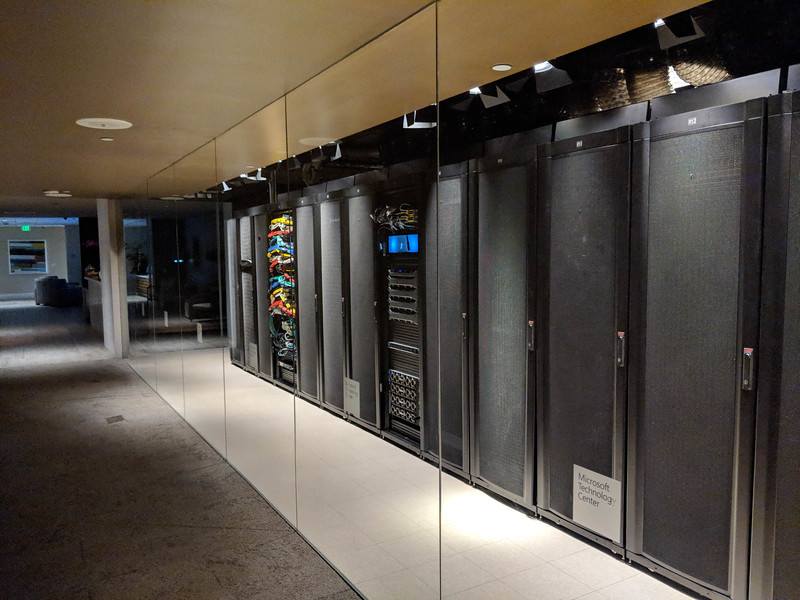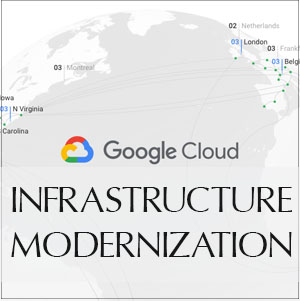Infrastructure Modernization Overview with GCP
Infrastructure Modernization with Google Cloud
New businesses that have fully been developing in the cloud are rightfully challenging older business models. Scale is no longer a competitive advantage, but rather has become the common place. Many organizations are aware of this threat coming from new organizations and it is leading to digital disruption. These legacy organizations want to know,
- “How do we best respond to this threat?”
- “How can we survive and thrive in this new cloud era?”
Central to an ability to thrive in this era is the way in which IT resources and structured and utilized. For example, this could mean moving from a model where we invest resources to run and maintain existing IT infrastructure, to focus on creating higher products and services. Within the cloud, we can develop and build new applications to build better engagement with customers and employees (while being faster, more secure and scalable). In order for us to leverage cloud technologies to really transform our business requires new collaboration, changing culture and processes, and enabling team productivity and innovation. When we move to the cloud, we also see significant financial benefit, including a model where we pay for fixed capacity to paying for only for what we use.
For many of us, Infrastructure Modernization is the foundation for digital transformation.

Modernizing IT Infrastructure
For most organizations, owning and operating IT infrastructure on-premises does not differentiate our business, but rather can be a burden that limits our staff in several different ways. For example, we have to take on arduous tasks related to infrastructure procurement, provisioning and maintenance. Scale can also not easily be added as we are locked into what we have on-premises and we are also forced to over-pay for performance to plan for peak usage. One we can solve this is to out-source our IT resources and migrate to the cloud.
Co-Location: how did we make our resources more efficient before the cloud?
Traditionally, we housed all our IT infrastructure within our own buildings, which means we had to pay for real-estate, security and staff to operate and maintain the equipment. Prior to the cloud, we could make this model more efficient by sharing our data centers with other companies in what is known as co-location. Here, one company sets up a large data-center and other businesses, including ours would rent part of that data-center. This means we no longer had to pay for costs with hosting our infrastructure, but we still needed to pay to maintain it.

With both on-premises and co-location models, value benefits only begin well after substantial amounts of capitol expenditure is dedicated.
Virtual Machines: how did we better utilize our hardware?
Even in the co-location model, our hardware servers were often heavily underutilized, we started to package operating systems and applications into a virtual machine (VMs). VMs share the same pool of physical processors, storage and network resources. This became a more and efficient and manageable way to utilize our hardware. Most of us remember using VMs to maximize our hardware regardless if we were on-premises or co-located. The problem, however, is that there is still a physical cap which is related to the capacity of the physical servers at the location, and there is still much upfront capital expenditure.
Infrastructure as a Service (IaaS)
Many of us are now outsourcing our infrastructure entirely. We are growing our services to deliver products to customers both regionally, and sometimes globally, therefor we need to scale securely and quickly. If we were to continue to try to use on-premises or co-location this would be very expensive. Why own our datacenters if we can out-source to a public cloud that offers Infrastructure as a Service (IaaS)? Now we no longer have the overhead of physical equipment and datacenters to maintain and can shift our costs from capital expenditure to operational expenditure. Public cloud providers such as Google Cloud, provide several services to help us modernize our infrastructure. We can choose to move all or just some of our infrastructure away from physical data centers to virtualized datacenters in the cloud. Google Cloud provides us compute, storage and network resources in a way that is familiar to how we handled these in our physical datacenters. Cloud Service Providers such as Google now also handle maintenance work as well. With this shift to out-sourcing the physical costs and maintenance from our datacenters, we now have money to focus on processes and applications that move our business forward.
Platform as a Service (PaaS)
Outsourcing physical resources to IaaS gives us plenty of flexibility but requires our teams to continue managing operating and application security such as web application security. If we wanted an even greater managed service, Cloud Service Providers offer Platform as a Service (PaaS). In this case, we no longer manage the infrastructure and in some cases we only pay for what we use.



Leave a Reply
Want to join the discussion?Feel free to contribute!